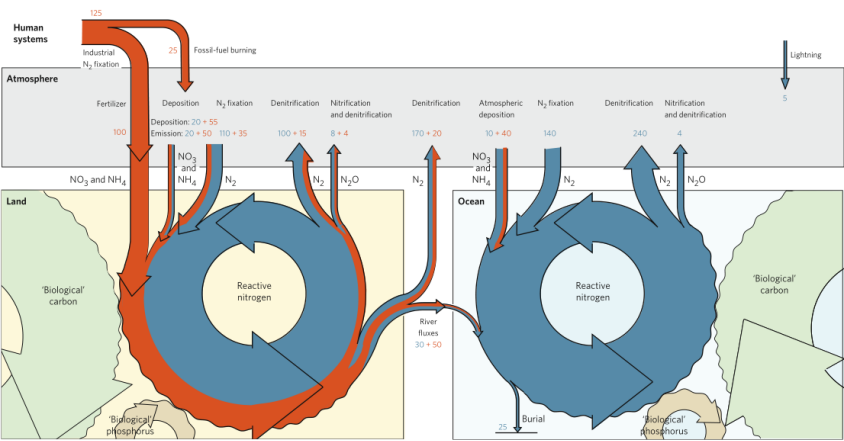近年来,随着工业革命的兴起,世界人口急剧增长,为了满足不断增长的食物需求,人们通过哈伯-博世过程和化石燃料燃烧,大量生产氮肥,以及大规模水产养殖活动、种植固氮豆类和其他人为活动,使得全球固氮量持续的升高,由此导致了一系列环境问题,如水体富营养化、温室效应、臭氧层被破坏等。过量活性氮的排放造成的环境问题已经严重影响了自然环境,甚至严重影响到了人类以及其他生物的赖以生存的栖息地。如图1所示,红色箭头为人为氮输入大大增加,已经远远超过了生态系统的自净能力。
In recent years, with the development of the industrial revolution and the dramatic growth of the world population, a continuous rise in global nitrogen fixation and a series of environmental problems such as eutrophication of water bodies, greenhouse effect and ozone layer depletion emerge under people’s producing nitrogen fertilizers in large quantities through the Haber-Bosch Process to meet the growing demand for food, fossil fuel combustion, mass production of nitrogen fertilizer, large-scale aquaculture, cultivation of nitrogen-fixing legumes and other activities. The environmental problems caused by excessive reactive nitrogen emissions have seriously affected the natural environment and even the habitats on which humans and other organisms depend. As shown in the Figure 1, the red arrows mean the anthropogenic nitrogen inputs which have greatly increased and has far exceeded the self-purification capacity of the ecosystem.

图1 人为活性氮在陆地与海洋中的转换与通量示意图(Nicolas Gruber et al., )
要想缓解人为活性氮大量输入到自然环境的问题,就必须提到两个途径——:反硝化作用(Denitrification)和厌氧氨氧化(Anammox)。反硝化作用分为化学反硝化作用和异养反硝化作用,是指在厌氧条件下,微生物将硝酸盐及亚硝酸盐还原为气态氮化物和氮气的过程,是活性氮以氮气形式返回大气的主要生物过程。但反硝化过程中会产生N2O气体,该气体是温室气体,其温室潜力约是CO2的300倍。厌氧氨氧化是一种生物过程,其中氨在厌氧条件下以亚硝酸盐作为末端电子受体氧化为N2,属于环境友好型。[1]这两个反应都是由微生物介导的,能够将其他氮形式转化为N2和N2O,而这两个都是气体,最终回归大气使氮污染得到了一定的缓解。厌氧氨氧化的发现改变了人们对氮循环的认识。在它被发现之前,唯一被认可的能够氧化铵的微生物过程是硝化作用,它通过需氧营养过程产生亚硝酸盐和硝酸盐。经过二十多年的发现,人们认识到厌氧氨氧化菌广泛存在,并已在土壤、地下水、废水处理厂、淡水和海洋沉积物、湖泊、河口、氧气最低区和海洋、极地地区、温泉、深海热液喷口和高盐场所。
To alleviate the problem of large inputs of anthropogenic reactive nitrogen into the natural environment, two methods must be mentioned and they are denitrification and anammox. Denitrification, divided into chemical denitrification and heterotrophic denitrification, is the process that microorganisms reduce nitrate and nitrite to gaseous nitrogen compounds and nitrogen gas under anaerobic conditions and is the main biological process that reactive nitrogen returns to the atmosphere in the form of nitrogen gas. However, the denitrification can produce N2O which is a kind of greenhouse gas whose damage to the environment is about 300 times than that of CO2. Anammox is a kind of environmentally-friendly biological process in which ammonia is oxidized to N2 under anaerobic conditions with nitrite as the terminal electron acceptor. Both methods can work under microorganisms’ converting other forms of nitrogen to N2 and N2O that are gases and can eventually return to the atmosphere, allowing some mitigation of nitrogen pollution. The discovery of anammox has changed people’s understanding of the nitrogen cycle. And prior to that discovery, the only recognized microbial process of oxidizing ammonia is nitrification which produces nitrite and nitrate through aerobic nutrient processes. After more than two decades, it is recognized that the anaerobic ammonia oxidizing bacteria are widespread and can be found in soils, groundwater, sewage treatment plants, fresh water, marine sediments, lakes, estuaries, oxygen minimum zones, oceans, polar regions, hot springs, deep-sea hydrothermal vents and hypersaline sites.
氨的厌氧氧化涉及的微生物过程(厌氧氨氧化、磺胺氨氧化、铁氨氧化和依赖NOM的厌氧氨氧化)在关键的海洋生物地球化学循环中起着重要作用,它们之间复杂的相互联系可能显著控制着海洋中基础元素的通量。此外,这些代谢能力在开发生物技术应用方面具有巨大潜力,以实现从含盐废水中去除含氮和含硫污染物,如水产养殖以及海产品、纺织品、药品等工厂产生的废水[2]。如图2所示即为污水排放中厌氧氨氧化菌的应用。
The anaerobic oxidation of ammonia is concerned with such microbial processes as anammox, sulfonamide ammonia oxidation, feammox, and NOM-dependent anammox whose complex interconnections may significantly control the flux of base elements in the ocean, and it plays an important role in the key marine biogeochemical cycle. In addition, these metabolic capabilities have a great potential for developing biotechnological applications to achieve the removal of nitrogen and sulfur-containing pollutants from saline wastewaters generated by aquaculture and factories for seafood, textiles, pharmaceuticals, etc. The application of anammox bacteria in wastewater discharge is shown in the Figure 2.

图2微生物脱氮在污水处理中的应用
尽管这些生物技术看起来很有前景,但为了优化工艺,需要解决几个方面的问题。例如,需要进行进一步的研究,以改善参与该过程的微生物的极低生长率,以及保留生物降解生物反应器的策略。此外,未来的研究还应阐明海洋中碳、氮、硫和铁的生物地球化学循环之间的复杂相互作用,以开发新的生物技术应用。
Although these biotechnologies seem to be promising, several aspects need to be addressed. For example, further research is needed to improve the very low growth rates of the microorganisms involved in the processes mentioned above, and some strategies should be proposed to retain biodegradable bioreactors. In addition, future research should elucidate the complex interactions among C, N, S and Fe of the biogeochemical cycles in the ocean to develop new biotechnological applications.
参考文献:
References:
[1]Dalsgaard T, Thamdrup B, Canfield DE. 2005. Anaerobic ammonium oxidation (anammox) in the marine environment. Res. Microbiol. 156:457–64
[2] Rios-Del Toro E E , Cervantes F J . Anaerobic ammonium oxidation in marine environments: contribution to biogeochemical cycles and biotechnological developments for wastewater treatment[J]. Reviews in Environmental Science and Bio/ Technology, 2019.
[3]HE Liming, KARLEP Liisi, LI Zhiyong. The Nitrogen-Cycling Network of Bacterial Symbionts in the Sponge Spheciospongia vesparium[J]. Journal of Ocean University of China, 2021, 20(04): 999-1012.
 公众号
公众号